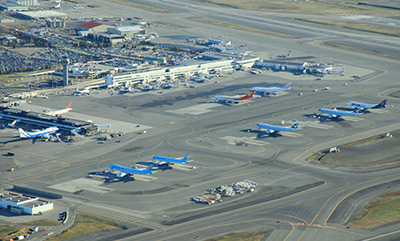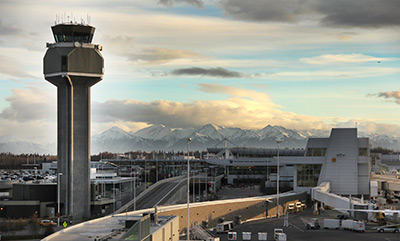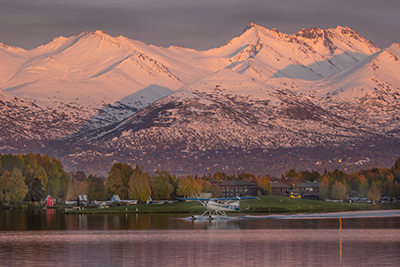Aircraft Noise at ANC
Noise
At the Anchorage International Airport, we take seriously our responsibility to minimize aircraft noise and its effects on surrounding communities. We work closely with FAA air traffic controllers to keep the public informed about any changes to flight paths or runway usage. While routine operations direct aircraft to fly over less populated areas—primarily over water to the north and west—there are occasions, such as adverse weather, emergencies, or winter operations, when temporary adjustments are necessary. During these times, aircraft may fly over residential neighborhoods. For example, if the primary north-south runway is unavailable, departures may be rerouted to the east. The Anchorage Air Traffic Control Tower selects flight paths based on flight safety and current and forecasted weather conditions. However, pilots have the final authority in determining which flight paths to accept. Regardless of circumstances, our focus remains on returning to standard noise reduction procedures as swiftly as possible.
Management

Runway closures can contribute to temporary adjustments in flight paths. Routine maintenance activities, including painting, lighting repairs, and surface inspections, are typically scheduled during daylight hours and planned in advance. Nonetheless, unexpected closures due to emergencies, aircraft-related issues, or adverse winter conditions may occur at any time. In situations where the north-south runway is unavailable, aircraft may be required to depart to the east, resulting in temporary impacts on nearby communities. All deviations from standard procedures are made with safety and operational efficiency as the highest priorities.
Wind Patterns

Local wind patterns are monitored and available from the National Weather Service (NWS). Because the airport sits at a higher elevation than surrounding neighborhoods, wind speeds there are generally higher. Wind conditions can vary significantly over short distances—while it may be calm in one neighborhood, just a mile or two north at the airport, wind speeds can be noticeably stronger.
Mitigation
The Anchorage International Airport is dedicated to efficiently managing runway closures, closely monitoring noise events, and collaborating with airlines and air traffic control to ensure smooth operations. As the bridge between the community and the aviation industry, ANC actively works to address and resolve any noise-related concerns. Our goal is to be a responsible and considerate neighbor to the surrounding communities, fostering positive relationships and minimizing disruptions.
Maintenance
Runway closures are typically scheduled for routine maintenance activities such as crack sealing, painting, lighting repairs, and inspections. To minimize disruption, these planned closures are limited to normal daytime hours. Information about upcoming closures is posted on our website, www.AnchorageAirport.com, and shared through our social media channels. Stay updated by following us on Facebook and X at @ANCairport.
Lake Hood

Lake Hood is the world's busiest seaplane base, and we recognize that aircraft noise impacts our neighbors. ANC encourages all pilots to voluntarily follow simple noise-reduction practices to help us be good neighbors.
Please avoid flying over residential areas whenever possible, especially on departure. Easterly departures should be minimized in favor of west, north, or south routes to reduce noise. Use smooth power changes and adjust power, RPM, and pitch for quieter flight when safe. Reducing prop speed helps cut propeller noise.
Climb efficiently using the best angle or rate to gain altitude quickly and lessen ground-level noise. Minimize overflights of homes and avoid unnecessary pattern work near residential zones.
We also ask pilots to limit operations between 10:00 PM and 7:00 AM to respect community quiet hours.
Frequently Asked Questions
Why are some flights louder than others?
Why do departure and arrival paths sometimes change?
What is a noise-abatement procedure?
How do I file a noise complaint?
FAA Noise Partnering:
- Alaskan Region Aircraft Noise and Community Engagement Information (faa.gov)
- FAA Aviation Noise Complaint and Inquiry Response (faa.gov)
- Responding to the Nation's Aviation Noise Concerns (faa.gov)
When submitting a noise event, providing a specific timeframe allows us to identify the runway configuration and the reason for any non-standard flight patterns. If your concern relates to standard traffic patterns or typical flight routes into or out of the airport, please note that the Federal Aviation Administration (FAA) is responsible for addressing those complaints. You can file FAA noise complaints by emailing 9-aal-noise@faa.gov or calling 1-907-271-5228.

